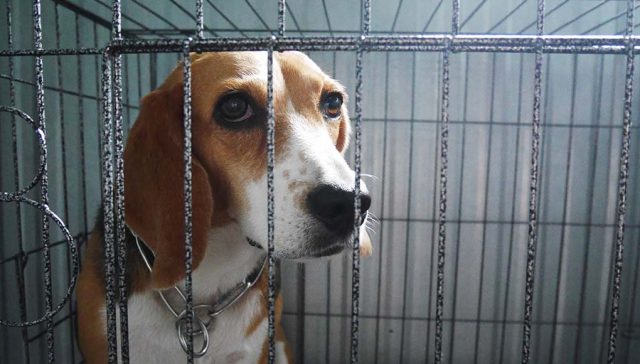
Table of Contents
- 9 Upsetting Truths About Dogs in Laboratory Experiments
- 1. There Are Dogs Specifically Bred for Laboratory Experiments
- 2. Research Facilities Also Acquire Shelter Dogs
- 3. The Scientists Train the Dogs to Trust People First
- 4. Every Year, Some 60,000 to 75,000 Dogs Are Used as Laboratory Subjects
- 5. Experimenting on Dogs Began Centuries Ago
- 6. Dogs Bred in Labs Are Deliberately Made to Suffer
- 7. The Dogs Are Also Poisoned
- 8. It's Not Unlawful for Dogs in Laboratories to Stay in Small Cages
- 9. The AWA Does Not Offer Any Limitations on the Dog Experiments
- In Conclusion…
Most dog lovers treat their pets as part of the family, but in many laboratories worldwide, some dogs are treated like disposable commodities used for scientific, medical, and educational experiments.
Do you know what happens to dogs used for laboratory experiments?
Here are nine upsetting truths about their condition in these institutions that educated men and women supposedly manage.
9 Upsetting Truths About Dogs in Laboratory Experiments
1. There Are Dogs Specifically Bred for Laboratory Experiments
Breeding dogs for the sole purpose of laboratory experiments are common among research facilities.
These institutions pay a premium price to licensed Class A breeders who supply the dogs.
Even dogs with birth defects are not off limits and may go for at least $700 each.
2. Research Facilities Also Acquire Shelter Dogs
Some institutions also pay a significant amount for shelter mutts that will be used for lab experiments.
As a result, some people might pose as interested adopters at these shelters who will actually sell the dogs to these facilities as Class B dealers, according to the Humane Society.
Obviously, this is a big money-making scheme for many unscrupulous individuals.
3. The Scientists Train the Dogs to Trust People First
Before the dogs are subjected to the experiments, they undergo proper training to learn to trust humans.
This way, the scientists will have an easier time working on their subjects.
However, this method has met heavy criticism from animal rights activists who point out the cruelty of the whole process.
After the dogs become trusting, they actually go through extreme mental, physical, and emotional stress due to the brutality of some of these experiments.
4. Every Year, Some 60,000 to 75,000 Dogs Are Used as Laboratory Subjects
According to the American Anti-Vivisection Society, some 60,000 to 75,000 dogs are used in laboratories annually.
Beagles are the most preferred breed, but some laboratories also use Golden and Labrador Retrievers, Greyhounds, Schnauzers, and Pit Bulls.
The number of dogs for experiments, however, has dropped since the '70s.
According to the NAVS, at least 200,000 dogs were used yearly in research, testing, and teaching back then.
Despite the 71% drop from four decades ago, animal activists still want the complete banning of animal experiments.
Because of technological advancements, there are plenty of alternatives for testing medicines and other products today that do not require hurting animals.
However, companies that do the tests still don’t want to shift their methods.
5. Experimenting on Dogs Began Centuries Ago
According to the Dallas Observer, anatomist and physicist Sir Christopher Wren first used dogs for laboratory experiments in the 1600s.
He injected wine and opium into the animal’s bloodstream to see its effects and reactions.
His discoveries led to blood transfusion, which opened doors for other medical advances like vaccination, insulin, open-heart surgery, and pacemakers.
6. Dogs Bred in Labs Are Deliberately Made to Suffer
Some of the dogs in these labs are used for studying various human diseases, so they are bred to carry genetic problems and deformities specifically.
For instance, a laboratory in Texas breeds Golden Retrievers with Duchenne Muscular Dystrophy (DMD) to closely study how this condition may affect humans, according to IndieWire.
Unfortunately, the experiments for this particular condition feel like torture for dogs.
Puppies were also bred specifically for studies on the cause of blindness in humans with degenerative eye disease at the University of Pennsylvania.
When the experiments concluded, the lab dogs were either killed or their eyes were removed, so they dealt with blindness for the rest of their short life.
7. The Dogs Are Also Poisoned
In most cases, laboratory dogs are guinea pigs for toxicity tests in various medical, biological, environmental, and cosmetics experiments.
The scientists inject the animals with deadly and poisonous substances that either make them violently ill or kill them.
8. It's Not Unlawful for Dogs in Laboratories to Stay in Small Cages
Dogs used in lab experiments sleep and live in very small cages, and it's not against the law.
The Animal Welfare Act (AWA) actually stipulates that kennels in these laboratories must be at least eight square feet.
But this is still too small for the dogs, and they end up suffering mentally from being cooped and contained in such a cramped space, according to a CBS report.
Worse, these dogs are locked in cages for years without ever experiencing sunshine or the outdoors.
Most of these dogs do not know a life outside the walls of the laboratories, so when they do get out after the experiments are done, they develop several physical and mental health issues.
9. The AWA Does Not Offer Any Limitations on the Dog Experiments
Though the law is supposedly for the welfare of animals, it's not enough to stop the experiments on dogs.
Laboratories may be subjected to checks by a committee, but the checks do not happen regularly, and the standards are loose.
There is no actual government body or entity that properly oversees how these labs operate.
In Conclusion…
You can do a lot to help dogs used in laboratory experiments.
Use your purchasing power as a consumer and taxpayer, and stop buying products whose companies are known to do animal testing.
You use many of these products daily, such as toothpaste or shampoos, laundry detergent, household cleaning materials, makeup, and other grooming items.
Research the companies online and switch to cruelty-free options if possible.
You may also educate your friends about the suffering of these animals in laboratories.
Support worthy causes if there are legislations and fundraisers in your state about the rights of animals.
Do you know that at least $16 billion of taxes go to animal experiments annually in the U.S. alone?
You have the right to speak up and talk to your legislators about making better laws for these dogs. Give these animals a voice.
How You Can Help
Here is a list of organizations that you can donate to.
Don't forget to spread awareness with other animal lovers.
These organizations specialize in rescuing animals from laboratories where these horrendous experiments go on:
Related Articles:
- 4 Ways This Major Pet Supplier Ties to Animal Cruelty
- 12 Horrifying Facts About the Lives of Laboratory Dogs
- 4 Common Ways People Abuse Animals













